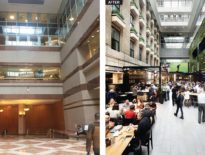
A former steam pump factory near Kendall Square now provides makerspaces, offices and performance space for community-based programming. Photo by Anton Grassl | Courtesy
New England abounds in old industrial structures, and while the region is no longer a manufacturing powerhouse, developers, architects and builders have a responsibility to adapt these structures for 21st century uses.
The city of Cambridge’s Foundry 101 is a prime example of the challenges and opportunities in transforming an old industrial eyesore into a welcome and much needed community resource.
Cambridge has become a global center of biotech, accompanied by an unprecedented building boom in Kendall Square. The Foundry, originally part of the 19th century Blake & Knowles steam pump factory complex, sits a block away from Binney Street, the unofficial boundary between Kendall Square and the East Cambridge neighborhood, and adjacent to a series of blocks that have only recently begun to see new construction.
This location provides an opportunity to bring the benefits of Kendall Square’s innovation economy to the East Cambridge residents. The Foundry is a singular project: owned by the city of Cambridge, developed in partnership with the Cambridge Redevelopment Authority and run by the nonprofit Foundry Consortium. Robust stakeholder engagement resulted in community-based programming that includes a flexible performance space, multipurpose rooms, art studios, dance, a demonstration kitchen, cafe and maker spaces, plus nonprofit and market-rate office space.
The renovation posed challenges common to old industrial properties, including site remediation necessitated by past uses, such as metal casting, a truck barn and taxi garage. Additionally, the threat of rising sea levels for this former inland marsh called for filling the basement and locating critical mechanical equipment on the roof.
Yet despite these challenges, the historic building offers unique opportunities. Industrial buildings tell stories about the history of their communities. The Foundry played a key role in advancing the women’s labor movement through worker advocacy and state legislation passing the first minimum wage law for women in the U.S. This story is chronicled in an exhibit located in the project’s Community Hall.
New Insertions Support Historic Frame
The Foundry, now a Cambridge historic landmark, also features architectural character that cannot be recreated. The renovation reveals historic heavy-timber and iron detailing. A new steel frame with separate foundations retains the same structural bays as the historic timber and supports infilled floors for the new program. The exposed, original columns support the restored historic masonry facade, which retains the texture and scale of late-19th century water-struck brick once common in the neighborhood.

Justin Crane
Reusing industrial architecture also provides opportunities for found spaces. By reorienting the Foundry entry and transforming Rogers Street, a private alley between two historic factory buildings, into a shared street with trees and benches, we linked the Foundry to a newly-opened city park one block away. Likewise, the full-height Community Hall, surrounded by interior glass walls and welcoming illumination from skylights, creates more usable perimeter space through the insertion of a second story between the ground and upper levels.
Repurposing existing industrial building stock is also environmentally responsible. The Foundry’s restoration and reuse of masonry, structure and roofing material saved it from landfills and conserved energy that would have been used to construct new materials. Further, the exceptionally thick historic masonry facade is shown, through energy modeling, to be effective in dampening temperature swings and to meet energy code without new insulation. Finally, the high window openings and skylights originally installed for work before electrification allow for well-lit spaces with minimal energy use.
Existing industrial buildings remain key to the urban fabric of New England cities. While they present challenges to adaptive reuse, they also provide opportunities for environmental responsibility, found spaces and historic character that can provide new assets for their communities.
Justin Crane is an associate principal at CambridgeSeven.






